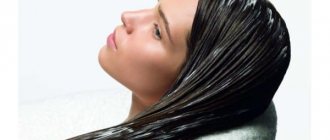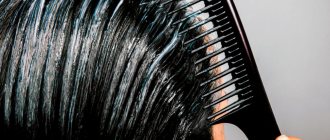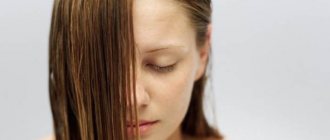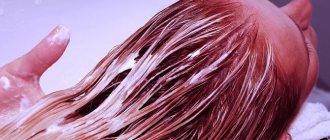Everyone knows how to wash your hair correctly: first you need to wet your hair, squeeze a little shampoo from the tube into your palm, apply it to the scalp with massaging movements, distribute it over the entire length of the hair, then rinse off the foam thoroughly. After shampoo, don’t forget about conditioner or balm - it’s best to leave such products on your hair for a couple of minutes and then rinse.
Every day, many people wash their hair the old-fashioned way, as they say, without thinking that today there are completely new ways to cleanse their hair. We will tell you about the most popular and effective ones.
Co-washing
And now we will talk about the most common hair washing, but not with shampoo, but with conditioner. African-American women invented this method of caring for their curls: by giving up shampoo, they were finally able to tame their unruly, coarse hair. First, rinse your hair thoroughly with water, it should be wet. Then apply the conditioner sparingly with massaging movements along the entire length. Take your time; the procedure should take at least five to seven minutes for the hair to be completely clean. It will also take a long time to wash off the conditioner. Many people recommend using this method for emergency hair moisturization.
Who is suitable for co-washing?
It is worth noting that co-washing is not for everyone. For example, if your hair tends to be oily, it may not give the desired results. However, there are some hair types that may benefit from conditioning. What are these hair types?
For example, curly hair
By the way, co-washing was invented for those with natural curly hair and even afro hairstyles. As you know, naturally curly hair is quite brittle and dry, has less shine and needs more moisture. Washing with conditioner will not dry them out and will help give them extra shine.
Bold curls require care. Credit: Rex by Shutterstock
Damaged hair
Most likely, damaged, overdried strands after perms and straightening will also benefit from conditioner instead of shampoo. Gentle cleansing will support other hair restoration measures.
Dyed and bleached hair
Of course, strands injured after bleaching and dyeing will also positively appreciate gentle cleansing with shampoo and conditioner. However, co-washing can cause pigments to wash out more quickly, so be careful. By the way, the ideal option is to take a course of co-washing after unsuccessful dyeing.
Do you want to wash off your boring hair color? Try co-washing. Credit: Rex by Shutterstock
Coarse hair
Hair with a coarse structure is not so common among Slavs. However, if you have strands that don't fit well and stick out in different directions, try moving the shampoo out of your bathroom. Definitely, co-washing can make your strands softer and more manageable.
Mature hair
Sometimes the hair of older people becomes very thin and fragile, and the scalp becomes excessively dry. In this case, co-washing can also become a panacea.
Which conditioner to choose for co-washing?
Co-washing does not require any special products, especially if you have thick and thick hair. The main rule is to avoid using silicone, parabens, and sulfates, which are very abundant in regular shampoos. They clog hairs, weighing them down, and silicone can lead to hair loss and brittleness. Therefore, it is best to choose conditioners with natural composition. There are a huge number of them. Price does not play a special role here; the air conditioner must meet the above requirements. Remember that there is no universal remedy, try and choose the best option specifically for your hair!
Carefully study the composition of the conditioner; it should not contain mineral oils, wax, paraffin, or components whose names end in -cone. The most famous of them is DimethiCONE. This is silicone. Silicone tends to accumulate on the hair, making it dull, and since the main goal of co-washing is to wash the hair and not weigh it down even more, the conditioner should be free of silicone. The following companies offer products without silicones:
- Grandmother Agafya's recipes.
- One hundred beauty recipes.
- Clean line (except for volume products or for colored hair).
- BIO.
- Eared nanny.
- Natura Siberica.
- Nivea.
- Lush.
- Neutrogena.
- Johnson's Baby.
And many other famous brands such as SYOSS Silicone Free, Garnier, Gliss Kur Schwarzkopf, Elseve Loreal Paris, Fructis.
If you have thin hair, then it is best to opt for special conditioners for co-washing (for example, NANO-Organik), or choose lighter, cleansing conditioners. They will rinse well without weighing down your hair.
Prewashing VS Cowashing
Two methods, two procedures and one fighter - hair conditioner. What is the difference?
If the main task of prewashing
– to protect
the length of the hair
from aggressive surfactants and water during washing, then
cowashing
is a gentle
cleansing of the hair and scalp
without the use of those same aggressive surfactants in principle.
The advantage of cowashing
The fact is that cleansing occurs without the inherent property of shampoo to “uncover” the hair scales. That is, very soft. It’s as if you cleansed your face not with foam, but with milk. Co-washing cannot thoroughly and deeply cleanse your hair, but you can arrange a “vacation” for the scalp and hair lengths that have already been damaged by aggressive surfactants.
Despite the common mission of both procedures - to treat hair with care - in terms of effectiveness and vector of action, these are two different methods with their own nuances.
- Prewashing
is about the effect
on the “hair body”
, this method is about protection, efficiency and relative multifunctionality. A wide range of applications on different types of hair, the ability to thoroughly cleanse the scalp of excess sebaceous secretion without harming the hair, adjustable effectiveness (depending on the length of time the product is left on the hair). - Co-washing
is about the effect
on the scalp
and gentle alkali-free
cleansing of hair lengths
without the use of anionic surfactants. This is an ideal way to cleanse very dry, damaged hair, especially curly hair. But it is not suitable for oily hair.
Which balms are best to use for co-washing?
Do I need to use a special cleansing conditioner for co-washing or can I get by with a regular one? In fact, you can use different conditioners. However, a conditioner specially designed for cleansing will do the job a little better. It has a little more cleansing ingredients than a regular balm. At the same time, the product softens and moisturizes the hair.
Gentle cleansing
Cleansing conditioner for cowashing TIGI Bed Head Calma Sutra
Editor's tip: Let's say a great example is the TIGI Bed Head Calma Sutra Co-Washing Conditioner. Its sulfate-free formula with Brazil nut and babassu oils gently cleanses dry, frizzy and damaged hair. In addition, the conditioner helps provide shine and easy combing.
Co-washing
Love Beauty and Planet “Happiness and Hydration” Cleansing Conditioner for Hair
Or you can try Love Beauty and Planet Happiness & Hydration Cleansing Conditioner. Its formula without sulfates, silicones, phthalates and dyes has already been appreciated by ATH editor Julia. See her review of cowashing and more details on how to condition your hair.
Gather reviews from real people and find out if you should wash your hair with conditioner.
Cowashing - a new hair cleansing system
Cowashing is a new word in hair care trends. In short, this is a hair cleansing process in which the main product, that is, shampoo, does not take part.
Co-washing helps keep dry hair healthy 4330
Cowashing is a copy of the English co-washing. Here we can give a very clear analogy: if regular shampoo is a wash, then co-washing products are a delicate dry cleaning, after which the curls become smoother and silkier than usual. Let's find out if you should get carried away with this trend?
Who is suitable for cowashing?
If your hair is too dry or excessively curly or wavy, chances are you will benefit from switching to cowashing. However, the main candidates for cowashing are women with colored hair. But people with healthy, straight hair may be disappointed in co-washing - it can become weighed down and become like tow. Also, those who suffer from problems such as oily roots and dermatitis should not take risks.
So, in short, cowashing can help in the following situations:
- for caring for very curly hair (in the USA this is just an African-American trend);
- for those with colored hair (cowashing can be especially useful for them);
- for cleansing natural but damaged hair;
- for straight hair, if the goal is to moisturize, increase its volume or density.
Cowashing hair step by step
Eliminating your shampoo cycle is a big step. Here are step-by-step instructions for a smooth transition to your new cowashing system.
1. Completely saturate your hair with water - your strands should be very wet: water loosens the layer of dirt, makes it easier to rinse, and also helps to distribute the conditioner evenly along the entire length of the hair.
2. Squeeze a sufficient amount of conditioner into your palm - enough to cover your hair from root to tip.
3. Massage the conditioner into your scalp and distribute it evenly to the ends. Then let the conditioner soak in for three to five minutes. If your hair is particularly dry or damaged, leave the product on even longer; it will act as a treatment mask.
4. Now rinse your hair, dry it in a towel and style it as usual. Bonus: You may find that you now need less styling product because your hair is less dry and more manageable.
Use a regular clarifying shampoo once every two to four weeks to avoid contamination from sweat, sebum, styling products or conditioner. Miracles don't happen, and dirt will inevitably accumulate, no matter how often you cowash.
Cowashing: reviews 4495
Balms for hair cowashing: features of action
The popularity of unusual cosmetics - conditioners designed specifically for cowashing, that is, cleansing hair without the participation of shampoo in this process, is growing every day. How are they different from ordinary ones?
Most hair washes contain trace amounts of active compounds called cationic surfactants. (Some common ones you may find in your conditioner's ingredient list are cetrimonium and behentrimonium chloride.) When mixed with water, these substances pick up tiny amounts of dirt, leaving hair clean but grease-free. At the same time, the conditioner for cowashing does not contain them, so the hair cuticle does not suffer from dehydration - remnants of natural sebum remain on it. This will not provide the familiar cleanliness: hair after cowashing feels like the second day after regular washing, however, there are smoother, softer and easier to style hair
As a rule, the packaging of these products indicates cleansing and conditioning factors, foaming level, and activation time (usually 3-5 minutes for all hair types). Please note that some cowashing balms are available in economical liter packaging: they are not cheap compared to conventional hair cleansers.











